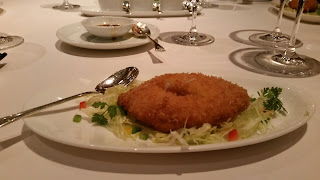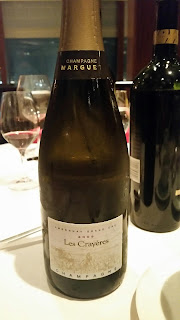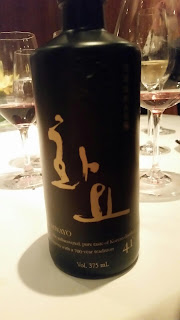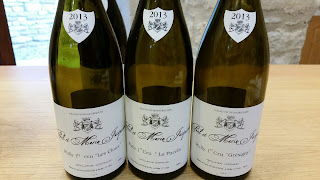"At its best, La Romanée has a remarkable silkiness and elegance, subtle dried fruit and rose petal aromas, lovely sweetness on the palate entry leading to a long cool and profound finish which lingers on the palate."
Here are the vintages that particularly stood out for Richard (note that between 2002 and 2005, both versions by Bouchard and Liger-Belair were shown):
5 star vintages: 1865, 1911, 1962, 1966, 1969, 2005 (Liger-Belair), 2008, 2010, 2011, 2012, 2013 and 2014 (cask sample)
4 star vintages: 1915, 1947, 1964, 1995, 2002 (Liger-Belair), 2003 (Liger-Belair), 2005 (Bouchard), 2006, 2007 and 2009
3 star vintages: 1923, 1926, 1949, 1952, 1953, 1957, 1971, 1980, 2001 and 2003 (Bouchard)
And a few that were above the expectations of the particular vintage (those nice surprises): 1967, 1973, 1974, 1975, 1976, 1981, 1987 and 1997
La Romanée first became a part of the portfolio of the Liger-Belair family when in 1815 General Louis Liger-Belair married the widowed Claire-Cécile Basire whose family had acquired important vineyard assets following the revolution, including the Château in Vosne, La Grande Rue , the first ouvrée of La Romanée and La Tâche. The General took on the title of Comte (Count) in 1822. Without heirs of their own, the couple in 1824 adopted Louis-Charles, the eldest son of the Count's sister, Marie-Catherine. Louis-Charles later inherited the vineyards of La Romanée, part of Richebourg, Les Gaudichots, La Grande Rue, Clos Saint Jacques in Gevrey, and he also reconstructed La Tâche. Louis-Charles married Ludovie Marey, daughter of Gauillaume-Felix Marey, cousin to the Marey-Monge family based in Pommard. The Marey family was based in Nuits-Saint-Georges, with the négociant house founded in 1720. In 1852, Count Louis-Charles went into partnership with his father-in-law and founded the House of C. Marey and Comte Liger-Belair. When his father-in-law passed away in 1869, Louis-Charles continued to run the business on his own before handing over to his son Edgard (1835 - 1915). Edgard (The Third Comte Liger-Belair) continued to build the domaine and the négociant business, focussing on the export business, in particular Belgium, where he was to meet his future wife. Of Edgard's children, Henri became the next Count, but he left the running of the business to his brother Felix. Henri (1867 - 1924) died young amidst very challenging economic times, leaving behind a widow and ten children. In France, a number of vineyards began to be sold off during the 1920s and 30s. Decision was made to auction off the Liger-Belair family vineyards on 31 August 1933. On that fateful day, Canon Just (1904-1991), one of Henri's 10 children, together with Michel (1900 - 1941), Henri's eldest, and another brother Philippe, managed to salvage La Romanée, Les Reignots and Les Chaumes.
Michel passed away in 1941. His son Henry (1928 - 2015) took over the domaine but because of his military duties (he became a full General in 1984), the tending of the vines continued to be under share-cropping arrangements with various Vosne families (including Forey, Lamadon, Sirugue and Michaudet), as had been organised by Canon Just. The Foreys had looked after La Romanée and Les Reignots. The wine was then handed over to a succession of Beaune-based négociant houses to finish the élevage for more than half a century, including Thomas-Bassot, Delaunay & Fils, Leroy, Lionel Bruck, Albert Bichot and Bouchard Père et Fils. The General and Count had 3 daughters and 1 son, and Louis-Michel became the 7th Count Liger-Belair in 2015 on the passing of his father.
Situated just above the slope from La Romanée-Conti, La Romanée is a monopole vineyard of 0.8452 hectare on a slope of 10-12%, that has been carefully pieced together through the consolidation of 6 parcels, acquired between 1815 and 1826. In 2015, 20% of the vines were 100 years old, 50% at 60 years and the remaining 30% between 20 and 40 years old. Average production is about 3,600 bottles. The rows are planted perpendicular to the slope (North-South), with exposure East/Northeast, for reasons of erosion but perhaps more for the practicality of alleviating field labour. The soil here contains less clay (35 - 40%) than La Romanée-Conti, with a stony structure, rendzina resting on Prémeaux oolith limestone. At the top of the plot (western side of parcel), the beige-pink limestones are compact, forming a thin crust, with outcrops of silica (silex-like) below the cross erected in the southwestern corner of this Grand Cru, where Les Reignots begins. In the middle, grey marl is covered with red gravel, with more limestone scree, clayey-limestone and brown silt on top. At the bottom eastern side, marl subsoil is covered with clayey limestone gravel, with brown silt on top. In short, La Romanée is a fragile vineyard, requiring a lot of work. Canon Just described it, "La Romanée is an upperclass who never entirely abandons herself......she always holds something back for later." If only he could live to taste the vintages under Louis-Michel's sole control!
5 star vintages: 1865, 1911, 1962, 1966, 1969, 2005 (Liger-Belair), 2008, 2010, 2011, 2012, 2013 and 2014 (cask sample)
4 star vintages: 1915, 1947, 1964, 1995, 2002 (Liger-Belair), 2003 (Liger-Belair), 2005 (Bouchard), 2006, 2007 and 2009
3 star vintages: 1923, 1926, 1949, 1952, 1953, 1957, 1971, 1980, 2001 and 2003 (Bouchard)
And a few that were above the expectations of the particular vintage (those nice surprises): 1967, 1973, 1974, 1975, 1976, 1981, 1987 and 1997
La Romanée first became a part of the portfolio of the Liger-Belair family when in 1815 General Louis Liger-Belair married the widowed Claire-Cécile Basire whose family had acquired important vineyard assets following the revolution, including the Château in Vosne, La Grande Rue , the first ouvrée of La Romanée and La Tâche. The General took on the title of Comte (Count) in 1822. Without heirs of their own, the couple in 1824 adopted Louis-Charles, the eldest son of the Count's sister, Marie-Catherine. Louis-Charles later inherited the vineyards of La Romanée, part of Richebourg, Les Gaudichots, La Grande Rue, Clos Saint Jacques in Gevrey, and he also reconstructed La Tâche. Louis-Charles married Ludovie Marey, daughter of Gauillaume-Felix Marey, cousin to the Marey-Monge family based in Pommard. The Marey family was based in Nuits-Saint-Georges, with the négociant house founded in 1720. In 1852, Count Louis-Charles went into partnership with his father-in-law and founded the House of C. Marey and Comte Liger-Belair. When his father-in-law passed away in 1869, Louis-Charles continued to run the business on his own before handing over to his son Edgard (1835 - 1915). Edgard (The Third Comte Liger-Belair) continued to build the domaine and the négociant business, focussing on the export business, in particular Belgium, where he was to meet his future wife. Of Edgard's children, Henri became the next Count, but he left the running of the business to his brother Felix. Henri (1867 - 1924) died young amidst very challenging economic times, leaving behind a widow and ten children. In France, a number of vineyards began to be sold off during the 1920s and 30s. Decision was made to auction off the Liger-Belair family vineyards on 31 August 1933. On that fateful day, Canon Just (1904-1991), one of Henri's 10 children, together with Michel (1900 - 1941), Henri's eldest, and another brother Philippe, managed to salvage La Romanée, Les Reignots and Les Chaumes.
Michel passed away in 1941. His son Henry (1928 - 2015) took over the domaine but because of his military duties (he became a full General in 1984), the tending of the vines continued to be under share-cropping arrangements with various Vosne families (including Forey, Lamadon, Sirugue and Michaudet), as had been organised by Canon Just. The Foreys had looked after La Romanée and Les Reignots. The wine was then handed over to a succession of Beaune-based négociant houses to finish the élevage for more than half a century, including Thomas-Bassot, Delaunay & Fils, Leroy, Lionel Bruck, Albert Bichot and Bouchard Père et Fils. The General and Count had 3 daughters and 1 son, and Louis-Michel became the 7th Count Liger-Belair in 2015 on the passing of his father.
It was at the young age of 8 that Louis-Michel knew he wanted to dedicate his life to wine and vines, and the domaine. Louis-Michel remained true to his vocation and commitment and has executed a carefully-planned campaign consisting of successive steps to rebuild and restore the Domaine du Comte Liger-Belair to its former glory and beyond. One of the first things he did was to execute the waiver agreements to the sharecropping leases, with remaining terms until between 2000 and 2002, depending on the vineyard. In 2000, he controlled only 1.5 ha, including La Colombière, Le Clos du Château (Monopole) and a few rows of Les Chaumes. In 2002, he took back the sharecropping arrangement for La Romanée and Les Reignots. Between the 2002 and 2005 vintages, both Bouchard and Liger-Belair shared the élevage of La Romanée, before the Bouchard arrangement discontinued. From 2006 vintage onwards, it is only produced by Domaine du Vicomte (now Comte) Liger-Belair. In 2014, Louis-Michel repurchased the historic Maison C. Marey & Comte Liger-Belair, founded in 1720 by Claude Marey. The domaine now has
Situated just above the slope from La Romanée-Conti, La Romanée is a monopole vineyard of 0.8452 hectare on a slope of 10-12%, that has been carefully pieced together through the consolidation of 6 parcels, acquired between 1815 and 1826. In 2015, 20% of the vines were 100 years old, 50% at 60 years and the remaining 30% between 20 and 40 years old. Average production is about 3,600 bottles. The rows are planted perpendicular to the slope (North-South), with exposure East/Northeast, for reasons of erosion but perhaps more for the practicality of alleviating field labour. The soil here contains less clay (35 - 40%) than La Romanée-Conti, with a stony structure, rendzina resting on Prémeaux oolith limestone. At the top of the plot (western side of parcel), the beige-pink limestones are compact, forming a thin crust, with outcrops of silica (silex-like) below the cross erected in the southwestern corner of this Grand Cru, where Les Reignots begins. In the middle, grey marl is covered with red gravel, with more limestone scree, clayey-limestone and brown silt on top. At the bottom eastern side, marl subsoil is covered with clayey limestone gravel, with brown silt on top. In short, La Romanée is a fragile vineyard, requiring a lot of work. Canon Just described it, "La Romanée is an upperclass who never entirely abandons herself......she always holds something back for later." If only he could live to taste the vintages under Louis-Michel's sole control!




































